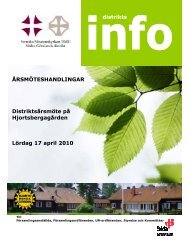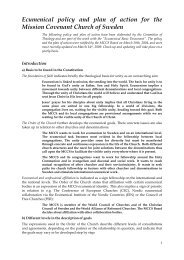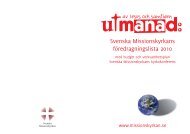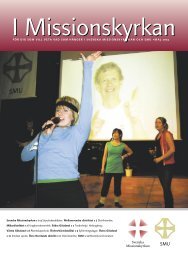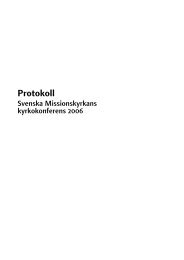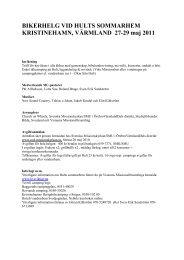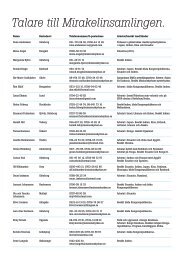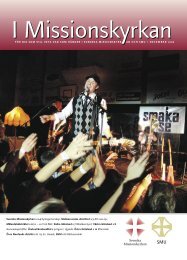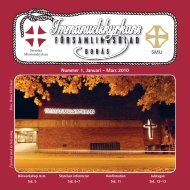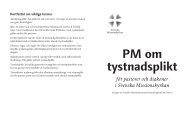Mission and Revolution in Central Asia - Svenska Missionskyrkan
Mission and Revolution in Central Asia - Svenska Missionskyrkan
Mission and Revolution in Central Asia - Svenska Missionskyrkan
You also want an ePaper? Increase the reach of your titles
YUMPU automatically turns print PDFs into web optimized ePapers that Google loves.
<strong>and</strong> not on the outside, which was the custom <strong>in</strong> their country.” 186 He tries hard, though, to<br />
create underst<strong>and</strong><strong>in</strong>g <strong>and</strong> sympathy for “the sometimes very primitive <strong>and</strong> self-contradictory<br />
ideas of this people”. 187 He writes about the school of piety with<strong>in</strong> Islam, where one tries to<br />
accumulate merits before God by keep<strong>in</strong>g the religious law, by do<strong>in</strong>g good deeds <strong>and</strong> by<br />
execut<strong>in</strong>g spiritual exercises. But there was also a deeper <strong>and</strong> more spiritual form of piety:<br />
“This other form of piety, which I th<strong>in</strong>k most Christians will be surprised to f<strong>in</strong>d among the Muslims is<br />
the k<strong>in</strong>d which has its roots <strong>in</strong> a wish to serve God for His own sake, <strong>and</strong> to atta<strong>in</strong> the highest aim of<br />
blessedness - to see God face to face. In both cases we f<strong>in</strong>d not only an honest search for truth <strong>and</strong> peace<br />
of m<strong>in</strong>d but also hypocrisy <strong>and</strong> false piety. Here is one more th<strong>in</strong>g that Christianity <strong>and</strong> Islam have <strong>in</strong><br />
common: the majority of their adherents lead a sham religious life without a real faith <strong>and</strong> ongo<strong>in</strong>g<br />
spiritual growth whereas the genu<strong>in</strong>e believers are only <strong>in</strong> m<strong>in</strong>ority.” 188<br />
The missionaries’ experiences of Islam <strong>in</strong> Eastern Turkestan were consequently quite varied.<br />
The two missionaries last quoted, Högberg <strong>and</strong> Raquette will suffice as examples. In 1919,<br />
when Högberg wrote his article, quoted above, he could look back on 22 years of missionary<br />
work <strong>in</strong> Eastern Turkestan. He had often written <strong>and</strong> spoken about the many dark aspects of<br />
Islam dur<strong>in</strong>g those years, <strong>and</strong> when he published his book Memoirs of a <strong>Mission</strong>ary <strong>in</strong> 1924,<br />
he was equally downcast. It might have been that he never found himself at home <strong>in</strong> this new<br />
<strong>Mission</strong> field. Already after his first term there, his go<strong>in</strong>g back was a matter of hesitation. 189<br />
And what could he ga<strong>in</strong> by his superficial presentation of Islam? The <strong>Mission</strong> surely did not<br />
benefit from it. Communications were certa<strong>in</strong>ly poor at that time, but there was still a chance<br />
of his views be<strong>in</strong>g known among Muslims <strong>in</strong> Eastern Turkestan. This is exactly what<br />
happened <strong>in</strong> the early 1930s, when Swedish Muslims tried to exploit these statements <strong>in</strong><br />
various ways. This happened dur<strong>in</strong>g the f<strong>in</strong>al years of the <strong>Mission</strong> era <strong>and</strong> will be treated later<br />
<strong>in</strong> this book. As to Raquette <strong>and</strong> his balanced <strong>and</strong> positive statements, they were written as<br />
late as 1925. By then he had been liv<strong>in</strong>g <strong>in</strong> his home country s<strong>in</strong>ce 1921 <strong>and</strong> the distance <strong>in</strong><br />
time <strong>and</strong> place probably contributed to his caution. To this should be added his vast<br />
knowledge of Islam. To his friendly attitude towards Islam he adds an unconditional belief <strong>in</strong><br />
the possibilities of Christian <strong>Mission</strong> <strong>in</strong> Eastern Turkestan. 190<br />
7. Eastern Turkestan Church History<br />
Among the very first th<strong>in</strong>gs known about Eastern Turkestan history of religion is the fact that<br />
people are said to have been worshippers of fire. 191 At an early stage, Buddhism penetrated the<br />
country. On its way to conquer Ch<strong>in</strong>a, Buddhism followed the road through Eastern<br />
Turkestan. 192 This form of Buddhism which now ga<strong>in</strong>ed a foothold <strong>in</strong> the country was called<br />
Mahayana, or Northern Buddhism. However after some centuries its <strong>in</strong>fluence dim<strong>in</strong>ished.<br />
The k<strong>in</strong>d of Buddhism exist<strong>in</strong>g <strong>in</strong> the country dur<strong>in</strong>g the mission era <strong>and</strong> which was ma<strong>in</strong>ly<br />
the religion of the Ch<strong>in</strong>ese population was mixed up beyond recognition with elements from<br />
ancient Ch<strong>in</strong>ese religions.<br />
186 SMT, 1913, p. 84.<br />
187 Raquette, 1935, p. 8.<br />
188 Ibid., p. 146 f.<br />
189 Ekman, 1903, p. 89.<br />
190 Raquette, p. 8. See also Myrdal, 1977, p. 70 f.<br />
191 Lundahl, 1917, p. 164 f.<br />
192 Anvill, 1932, p. 124 ff.<br />
23



